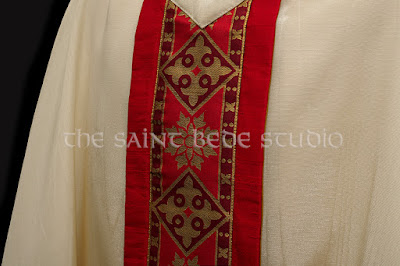In this post, we review a set of vestments in the Saint Bede Studio's Saint Anselm style.
This style of chasuble, which we have been making for several years now, is simple and comfortable to wear. Although the chasuble is unlined, it is made from substantial, not flimsy material, so that it hangs down well. Around the neckline, on the underside of the chasuble is a facing, which causes the vestments to sit well on the shoulders.
Concerning the appearance of this vestment, it is intended to be a mixture of the contemporary and the traditional. It is a long chasuble and reaching near to the wrists. It is ornamented simply. The colour of the ornament varies, but consists of two columns made from silk with a selection of the Studio's unique braids.
In the case of this chasuble, the Studio's braid Saint George is laid upon pendants of vibrant red silk dupion. These pendants are attached to the front and to the back of chasuble.
Each of these simpler chasubles is supplied with a fully-lined stole. They are available in all the liturgical colours.
Please click on the images for an enlarged view.
The vestments of the Saint Bede Studio are beautiful in design, sound in construction and distinctive in appearance.
Information on placing an order.
AMDG



















